Spending time on the tummy is important for developing your infant's strength and flexibility. In earlier times infants were put down on their tummies to sleep and so quickly learned how to push up on their forearms and lift their heads. Today infants mostly sleep on their backs and as a result very young infants take a little longer to reach these early milestones and need special tummy play time to get them used to position.
The highlighted numbers indicate the age in weeks that 50-90 % of typically developing infants develop each of the basic tummy time skills. These are roughly based on the AIMS scales. Use the corrected age for preterm infants and even then you may find that your infant is slower to develop the basic movement patterns.
|
0 1 2 3 4 5 6 Newborn flexion
Can lift the head to the side very briefly. Premature infants tend to lie with their arms and legs more extended. |
|
0 1 2 3 4 5 6 7 Early forearm prop position
Elbows now slightly in front of the shoulders. Lifts head past 450. |
|
2 3 4 5 6 7 8 9 Active forearm support
|
|
2 3 4 5 6 7 8 9 Starting to push up on straight arms
Chest is lifted off the surface. Pushing up on the arms helps to strengthen the arms and back, and also stretches the hip muscles. |
|
3 4 5 6 7 8 9 10 Swimming
Infants who do not spend time on the tummy do not develop the strength to get into this position.
|
|
3 4 5 6 7 8 9 Reaches up with one arm
This requires shifting the weight to one side |
|
2 3 4 5 6 7 8 9 10 11 Pivoting around
To do this the infant needs to coordinate the movements of the arms and legs. Pivoting also stretches the back and hip muscles.
|
|
4 5 6 7 8 9 10 11 12 Propped on forearm lying on the side
|
|
4 5 6 7 8 9 10 11 12 Creeping (commando crawling) on the tummy
Creeping is hard work and really develops trunk strength and flexibility. Some infants do not creep. |
|
5 6 7 8 9 10 11 12 Pushes up onto all fours 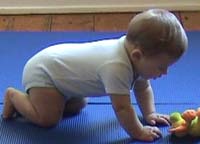 Legs are quite wide apart at first. Legs are quite wide apart at first.Starts to rock backwards and forwards. Over time the legs move closer and the baby is able to lift one arm to reach for toys. |
|
6 7 8 9 10 11 12 Moves from all fours into sitting position |
|
6 7 8 9 10 11 12 13 14 Crawling
|
 Lies with arms and legs flexed and close to the body and head turned to one side.
Lies with arms and legs flexed and close to the body and head turned to one side.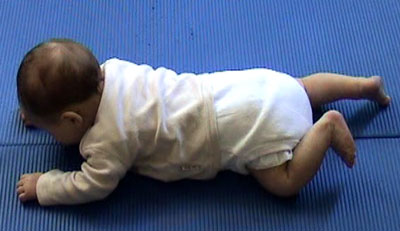 Supports on forearms and start to lift chest
Supports on forearms and start to lift chest Supports self on forearms and can play in this position.
Supports self on forearms and can play in this position. 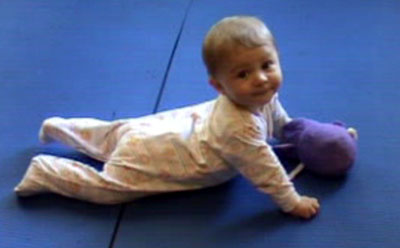 Hips are less wide apart (abducted). Knees may be bent or straight.
Hips are less wide apart (abducted). Knees may be bent or straight.  Lifts chest and sometimes the legs up with arms lifted sideways.
Lifts chest and sometimes the legs up with arms lifted sideways.  Supports self on one arm and lifts the other to reach for a toy. The hips an knees are fairly straight and less far apart than earlier with the the thighs more or less parallel.
Supports self on one arm and lifts the other to reach for a toy. The hips an knees are fairly straight and less far apart than earlier with the the thighs more or less parallel. 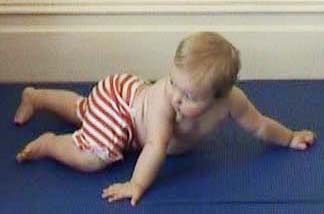 Infant turns around on the spot.
Infant turns around on the spot.  Lies on side supporting self on one arm.
Lies on side supporting self on one arm.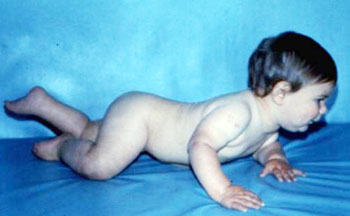 Infant creeps forwards on tummy using alternating arm and leg movement
Infant creeps forwards on tummy using alternating arm and leg movement The infant lowers the lowers the buttocks – as he practises this movement he is strengthening the trunk and arm muscles and learning to twist the trunk.
The infant lowers the lowers the buttocks – as he practises this movement he is strengthening the trunk and arm muscles and learning to twist the trunk. It takes quite a bit of practice before infant to figures out how to coordinate the actions of the arms and legs to move forwards with a reciprocal action.
It takes quite a bit of practice before infant to figures out how to coordinate the actions of the arms and legs to move forwards with a reciprocal action. 